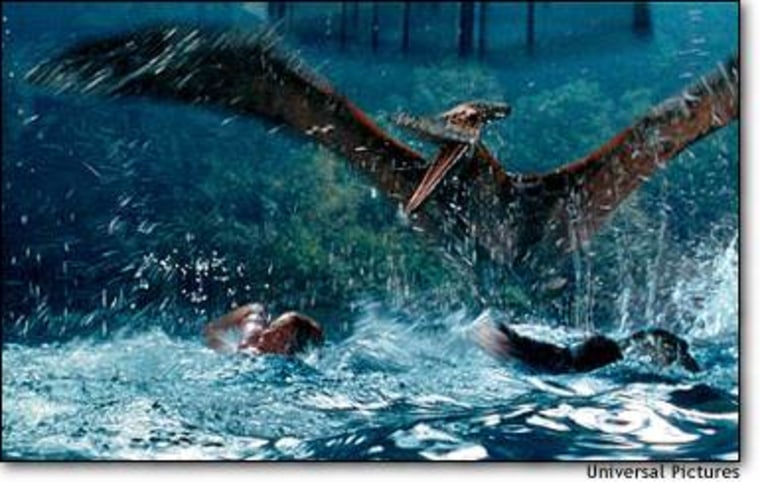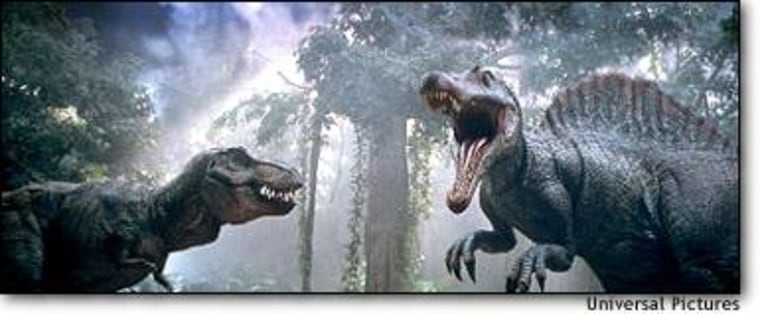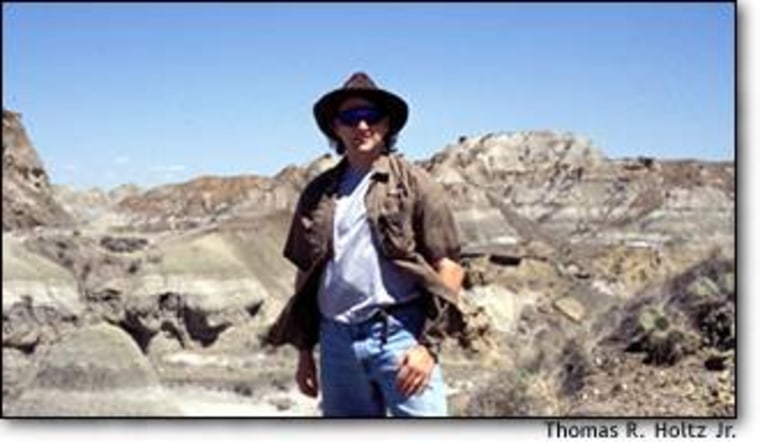Could a Spinosaurus really take on a big bad T. rex? Could a pteranodon really fly away with a 12-year-old boy? How realistic are those dinosaurs on the big screen, anyway? Those are the kinds of questions that intrigue paleontologist Thomas R. Holtz Jr., who wrote the book on the dinosaurs of “Jurassic Park.” The answers? Respectively, they’re yes ... no ... and it depends.
Holtz is a professor at the University of Maryland who specializes in the study of theropod dinosaurs like Tyrannosaurus rex. He served as a consultant for “Walking With Dinosaurs” as well as “When Dinosaurs Roamed America.”
“Jurassic Park III” is also close to his heart: Although he wasn’t involved with the movie itself, he got an early peek at the screenplay so that he and fellow paleontologist Michael Brett-Surman could write “Jurassic Park Institute Field Guide,” aimed at kids who want to know more about the science behind the story.
It should come as no surprise to those familiar with the Hollywood jungle that the film’s dinosaurs don’t exactly play it by the book.
Reality bites
The animation and puppetry in “Jurassic Park III” are top of the line, and the action is “very much in the adventure flick genre,” Holtz said. “But there seems to be less of an attempt to do realistic dinosaurs than there was in the first two movies,” he said.
To cite just one example, a horned theropod dinosaur that pops up during the movie “is sort of unidentifiable,” although Holtz thinks the animators were going for Ceratosaurus. “The shape of the horn was incorrect, the whole shape of the skull was incorrect,” he said.
In another scene, a winged pteranodon creeps up on an unsuspecting boy and opens its mouth to display rows of teeth. “But the word ‘pteranodon’ means ‘wings without teeth.’ That was kind of odd; I don’t know why the animators did that,” Holtz said.

“They have the pteranodon carrying a 12-year-old boy without much effort, but a 12-year-old boy is a lot heavier than a pteranodon,” he said. “Here you have something 50 or 70 pounds carrying something heavier than itself. Now, a Quetzalcoatlus, that would be different.”
Holtz also thinks the raptors — cast as the street gangs of “Jurassic Park” — are starting to move into a realm of full dinosaur fantasy. “The raptors (in the movie) are becoming more and more removed from Velociraptor in terms of appearance, to the point where you actually see the X-ray of the skull of Velociraptor and it has almost no bearing on the true skull,” he said.
In “Jurassic Park III,” dinosaurs also exhibit an intelligence far in excess of their brain capacity. In reality, “they were among the brainiest creatures of the Mesozoic (but) they still fall at the lower end of the bird and mammal range,” Holtz said. He also chuckled at the line claiming that the raptors were smarter than bottlenose dolphins and primates — a statement put in the mouth of a primate paleontologist.
If they’re so smart, “getting off the island would be one of the first things to do — and then take over the world,” Holtz said.
The movie also gives only the slightest nod to one of the hottest debates in the dinosaur field: whether the darn things had feathers. In “When Dinosaurs Roamed America,” the raptors are so covered with feathers that they almost look like killer emus. In contrast, the only evidence seen on the raptors of “Jurassic Park III” is the occasional crest of feathers on their heads.
“The producers probably had to decide, do we go with the latest discoveries and make the star creatures look radically different, or do we keep them consistent with the previous movies?” Holtz speculated.
Keeping up with reality
Perhaps it’s actually a sign of how far paleontologists and producers have come that they can debate the finer points of dino-anatomy. For “When Dinosaurs Roamed America,” Holtz and other consultants could log onto a collaborative Web site to double-check drawings and scripts for scientific accuracy. The experts debated online how the Quetzalcoatlus’ wing membrane might have been stretched over its frame, and whether the Early Jurassic creatures represented by fossils from the American Southwest might also have been found on the East Coast.
“When Dinosaurs Roamed America” also incorporates findings from New Mexico’s Zuni Basin that were published only a few weeks before the show’s television premiere. The most notable find was Nothronychus, a seeming relative of Tyrannosaurus rex that was a plant-eater instead of a meat-eater.

Even “Jurassic Park III” is keeping up with paleontological trends, highlighting a “rising star” of the dinosaur world called Spinosaurus, Holtz said.
“It was very cool to have Spinosaurus as the main villain,” he said. “Apparently, this Spinosaurus has a real taste for humans, because it chases them all over the island instead of going after other dinosaurs.”
If the spinosaurs were actually living today, they would probably find humans to their liking.
“They were at least in part fish-eaters, and they would use these crocodile-like jaws to hold onto fish about the size of a human being and gulp them down,” Holtz said. “So them going after something the size of a human is pretty reasonable. In fact, it’s probably more reasonable that a Spinosaurus would go after a human than a Tyrannosaurus.”
The biggest and the baddest
In reality, the two terror-saurs were separated by the early Atlantic Ocean and about 30 million years — but hypothetically speaking, Holtz says it wouldn’t be surprising if Spinosaurus could take down the king of the reptiles.
“When you’re dealing with these supergiant predators, it’s like, what’s stronger, a crocodile or a lion? Whatever gets a good grip on the other one wins,” Holtz said.
But Mother Nature would probably be the biggest, baddest adversary for the residents of a real-life Jurassic Park: From what Holtz has seen, there’s just no way that one lush tropical island could support the nutritional requirements for herds of dinosaurs.
“Flying over the island, you should see these totally denuded areas where the Brachiosaurus has gone through,” he said.
In fact, he suggested that the plot for “Jurassic Park IV” could take an eco-conscious turn.
“You have concern on the part of environmental activists that, OK, you brought these animals back, now you’ve got to take care of them — because this island is not the place where you can keep them,” he said.
